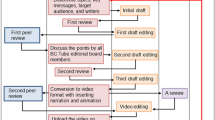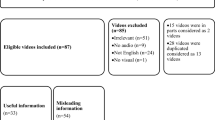Abstract
Background
The general population is increasingly using YouTube as a source of information on breast cancer, the most frequent cancer among women. Arabs are the most interested population in breast cancer on YouTube. The transmission of accurate information is important to reduce mortality rates. This cross-sectional study aims to evaluate breast cancer videos on YouTube in the Arab world.
Methods
A YouTube search for “breast cancer” in Arabic was performed. The most viewed 60 videos included were evaluated for global quality (GQS score), reliability (modified DISCERN score), content (content score), and misleading claims. Recorded and calculated data included views, duration, videos power index, and viewers’ interaction. Sources from legal persons (governments, universities, TV channels, physicians’ groups), and blogs (online health channels, individuals) were categorized.
Results
The median global quality (3/5), reliability (2/5), and content scores (4/11) were overall low. Misleading information was found in 42% of the videos. Although videos uploaded by legal persons were less popular (163,454 vs 327,488 views), they hosted more physicians (52% vs 15%), were less misleading (15% vs 64%), covered more content, and were of higher global quality and reliability than videos uploaded by blogs [p < 0.05]. While the topic of symptoms (55%) was discussed the most, genetic counseling (13%) and prevention (20%) were the least mentioned.
Conclusions
YouTube is poorly informational and inaccurate on breast cancer in the Arab World where it is highly used. Although videos uploaded by legal persons tend to be more adequate, they are of lower popularity. Governments and physicians are encouraged to upload more intelligibly informational videos, guide the population to reliable sources, and support regulations.




Similar content being viewed by others
Data availability
The datasets generated during and analyzed during the current study are available in the Figshare repository, https://figshare.com/s/c1a19106e0d67bbe1e48.
Code availability
N/A
Abbreviations
- GQS:
-
Global quality scale
- CDC:
-
Centers for Disease Control and Prevention
References
World Health Organization (2018) Breast cancer. https://www.who.int/cancer/prevention/diagnosis-screening/breast-cancer/en/. 2020
Elmore JG, Armstrong K, Lehman CD, Fletcher SW (2005) Screening for breast cancer. JAMA 293(10):1245–1256. https://doi.org/10.1001/jama.293.10.1245
Velasco E, Agheneza T, Denecke K, Kirchner G, Eckmanns T (2014) Social media and Internet-based data in global systems for public health surveillance: a systematic review. Milbank Q 92(1):7–33. https://doi.org/10.1111/1468-0009.12038
Amante DJ, Hogan TP, Pagoto SL, English TM, Lapane KL (2015) Access to care and use of the Internet to search for health information: results from the US National Health Interview Survey. J Med Internet Res 17(4):e106. https://doi.org/10.2196/jmir.4126
Powell J, Inglis N, Ronnie J, Large S (2011) The characteristics and motivations of online health information seekers: cross-sectional survey and qualitative interview study. J Med Internet Res 13(1):e20. https://doi.org/10.2196/jmir.1600
Raikos A, Waidyasekara P (2013) How useful is YouTube in learning heart anatomy? Anat Sci Educ 7(1):12–18. https://doi.org/10.1002/ase.1361
Madathil KC, Rivera-Rodriguez AJ, Greenstein JS, Gramopadhye AK (2015) Healthcare information on YouTube: a systematic review. Health informatics J 21(3):173–194. https://doi.org/10.1177/1460458213512220
Karlsen R, Borrás Morell J, Fernández Luque L, Traver SV (2013) A domain-based approach for retrieving trustworthy health videos from YouTube. Stud Health Technol Inform 192:1008
YouTube (2019) Press. https://www.youtube.com/intl/en-GB/yt/about/press/. 2020
McHugh SM, Corrigan M, Morney N, Sheikh A, Lehane E, Hill ADK (2010) A quantitative assessment of changing trends in Internet usage for cancer information. World J Surg 35(2):253–257. https://doi.org/10.1007/s00268-010-0830-8
Fogel J, Albert SM, Schnabel F, Ditkoff BA, Neugut AI (2002) Use of the Internet by women with breast cancer. J Med Internet Res 4(2):e9. https://doi.org/10.2196/jmir.4.2.e9
Satterlund MJ, McCaul KD, Sandgren AK (2003) Information gathering over time by breast cancer patients. J Med Internet Res 5(3):e15. https://doi.org/10.2196/jmir.5.3.e15
Uprety D, Adhikari J, Sharma P, Arjyal L (2016) Youtube as a source of information on cervical cancer. N Am J Med Sci 8(4):183. https://doi.org/10.4103/1947-2714.179940
Singh AG, Singh S, Singh PP (2012) YouTube for information on rheumatoid arthritis–a wakeup call? J Rheumatol 39(5):899–903. https://doi.org/10.3899/jrheum.111114
Kovalski LNS, Cardoso FB, D’Avila OP, Corrêa APB, Martins MAT, Martins MD et al (2019) Is the YouTubeTM an useful source of information on oral leukoplakia? Oral Dis 25(8):1897–1905. https://doi.org/10.1111/odi.13161
Li M, Yan S, Yang D, Li B, Cui W (2019) YouTubeTM as a source of information on food poisoning. BMC Public Health 19(1):952. https://doi.org/10.1186/s12889-019-7297-9
Loeb S, Sengupta S, Butaney M, Macaluso JN, Czarniecki SW, Robbins R et al (2019) Dissemination of misinformative and biased information about prostate cancer on YouTube. Eur Urol 75(4):564–567. https://doi.org/10.1016/j.eururo.2018.10.056
Google Trends (2020) Google Trends. https://trends.google.com/trends/explore?date=today%205-y&gprop=youtube&q=%2Fm%2F0j8hd. 2020
Internet World Stats (2019) Middle East Internet statistics, population, Facebook and telecommunications reports. https://www.internetworldstats.com/stats5.htm. 2020
Oremule B, Patel A, Orekoya O, Advani R, Bondin D (2019) Quality and reliability of YouTube videos as a source of patient information on rhinoplasty. JAMA Otolaryngol Head Neck Surg 145(3):282. https://doi.org/10.1001/jamaoto.2018.3723
Mueller SM, Jungo P, Cajacob L, Schwegler S, Itin P, Brandt O (2019) The absence of evidence is evidence of non-sense: cross-sectional study on the quality of psoriasis-related videos on YouTube and their reception by health seekers. J Medical Internet Res 21(1):e11935. https://doi.org/10.2196/11935
Erdem MN, Karaca S (2018) Evaluating the accuracy and quality of the information in kyphosis videos shared on YouTube. Spine 43(22):E1334–E1339. https://doi.org/10.1097/brs.0000000000002691
Oztermeli A, Karahan N (2020) Evaluation of YouTube video content about developmental dysplasia of the Hip. Cureus 12(8):e9557. https://doi.org/10.7759/cureus.9557
Hassona Y, Taimeh D, Marahleh A, Scully C (2016) YouTube as a source of information on mouth (oral) cancer. Oral Dis 22(3):202–208. https://doi.org/10.1111/odi.12434
American Cancer Society (2018) Breast Cancer. https://www.cancer.org/cancer/breast-cancer.html. 2020
Bernard A, Langille M, Hughes S, Rose C, Leddin D, Veldhuyzen van Zanten S (2007) A systematic review of patient inflammatory bowel disease information resources on the World Wide Web. Am J Gastroenterol 102(9):2070–7. https://doi.org/10.1111/j.1572-0241.2007.01325.x
Charnock D, Shepperd S, Needham G, Gann R (1999) DISCERN: an instrument for judging the quality of written consumer health information on treatment choices. J Epidemiol Community Health 53(2):105–111. https://doi.org/10.1136/jech.53.2.105
Centers for Disease Control and Prevention (2019) Breast Cancer. https://www.cdc.gov/cancer/breast/index.htm. 2020
IstiZada (2020) Complete list of Arabic speaking Countries – 2020. Update https://istizada.com/complete-list-%20of-arabic-speaking-countries-2014/. 2020
El Saghir NS, Khalil MK, Eid T, El Kinge AR, Charafeddine M, Geara F et al (2007) Trends in epidemiology and management of breast cancer in developing Arab countries: a literature and registry analysis. Int J Surg 5(4):225–233. https://doi.org/10.1016/j.ijsu.2006.06.015
Saggu S, Rehman H, Abbas Z, Ansari A (2015) Recent incidence and descriptive epidemiological survey of breast cancer in Saudi Arabia. Saudi Med J 36(10):1176–80. https://doi.org/10.15537/smj.2015.10.12268
Bevers TB, Helvie M, Bonaccio E, Calhoun KE, Daly MB, Farrar WB et al (2018) Breast cancer screening and diagnosis, version 3.2018, NCCN clinical practice guidelines in oncology. J Natl Compr Canc Netw 16(11):1362–89. https://doi.org/10.6004/jnccn.2018.0083
Yurdaisik I (2020) Analysis of the most viewed first 50 videos on YouTube about breast cancer. BioMed Res Int 27(2020):1–7. https://doi.org/10.1155/2020/2750148
Fox S (2011) Food safety, drug safety, and pregnancy information are among eight new topics included in our survey. Pew Research Center: Internet, Science & Tech [accessed 5 Aug 2020] Available from: https://www.pewresearch.org/internet/2011/02/01/health-topics-2/
Qi J, Trang T, Doong J, Kang S, Chien AL (2016) Misinformation is prevalent in psoriasis-related YouTube videos. Dermatol Online J 22(11):13030/qt7qc9z2m5. https://doi.org/10.5070/D32211033142
Lee JS (2014) YouTube as a source of patient information on gallstone disease. World J Gastroenterol 20(14):4066. https://doi.org/10.3748/wjg.v20.i14.4066
Lidz CW, Albert K, Appelbaum P, Dunn LB, Overton E, Pivovarova E (2015) Why is therapeutic misconception so prevalent? Camb Q Healthc Ethics 24(2):231–241. https://doi.org/10.1017/s096318011400053x
Biggs TC, Bird JH, Harries PG, Salib RJ (2013) YouTube as a source of information on rhinosinusitis: the good, the bad and the ugly. J Laryngol Otol 127(8):749–754. https://doi.org/10.1017/s0022215113001473
Reddy K, Kearns M, Alvarez-Arango S, Carillo-Martin I, Cuervo-Pardo N, Cuervo-Pardo L, Dimov V, Lang DM, Lopez-Alvarez S, Schroer B, Mohan K, Dula M, Zheng S, Kozinetz C, Gonzalez-Estrada A (2018) YouTube and food allergy: an appraisal of the educational quality of information. Pediatr Allergy Immunol 29(4):410–416. https://doi.org/10.1111/pai.12885
Plackett R, Kaushal A, Kassianos AP, Cross A, Lewins D, Sheringham J et al (2020) Use of social media to promote cancer screening and early diagnosis: scoping review. J Med Internet Res 22(11):e21582. https://doi.org/10.2196/21582
Mansour D, Nashwan A, Abu Rasheed H, Hararah M, Nassar H, Abu Abbas R et al (2018) Use of social media in breast cancer awareness: GCC countries’ experience. J Glob Oncol 4((Supplement 2)):30s30s. https://doi.org/10.1200/jgo.18.66200
The 1st combined Gulf Cancer Conference Awareness Strategy: reality and ambition. The Gulf Journal of Oncology (2017) May;(24). [accessed May 2021] Available from: http://www.gffcc.org/journal/docs/issue24/pp75-83_Highlights%20of%201stGulfConference.pdf
Al-Saleh K, Al-Awadi A, Soliman NA, Mostafa S, Mostafa M, Mostafa W et al (2016) Timing and outcome of referral to the first stand-alone palliative care center in the eastern Mediterranean region, the Palliative Care Center of Kuwait. Am J Hosp Palliat Care 34(4):325–9. https://doi.org/10.1177/1049909115625959
Aldabbagh D, Alsharif K, Househ MS (2013) Health information in the Arab world. Stud Health Technol Inform 190:297–9
U.S. Department of Health and Human Services (2010) National action plan to improve health literacy. https://health.gov/our-work/health-literacy/national-action-plan-improve-health-literacy
Hadden K, Martin R, Prince L, Barnes CL (2019) Patient health literacy and diabetic foot amputations. J Foot Ankle Surg 58(5):877–879. https://doi.org/10.1053/j.jfas.2018.12.038
Warde F, Papadakos J, Papadakos T, Rodin D, Salhia M, Giuliani M (2018) Plain language communication as a priority competency for medical professionals in a globalized world. Can Med Educ J 9(2):e52-59. https://doi.org/10.36834/cmej.36848
Gokcen HB, Gumussuyu G (2019) A quality analysis of disc herniation videos on YouTube. World Neurosurg 124:e799-804. https://doi.org/10.1016/j.wneu.2019.01.146
Esen E, Aslan M, Sonbahar BÇ, Kerimoğlu RS (2018) YouTube English videos as a source of information on breast self-examination. Breast Cancer Res Treat 173(3):629–635. https://doi.org/10.1007/s10549-018-5044-z
Mueller SM, Hongler VNS, Jungo P, Cajacob L, Schwegler S, Steveling EH et al (2020) Fiction, falsehoods, and few facts: cross-sectional study on the content-related quality of atopic eczema-related videos on YouTube. J Med Internet Res 22(4):e15599. https://doi.org/10.2196/15599
Tolu S, Yurdakul OV, Basaran B, Rezvani A (2018) English-language videos on YouTube as a source of information on self-administer subcutaneous anti-tumour necrosis factor agent injections. Rheumatol Int 38(7):1285–1292. https://doi.org/10.1007/s00296-018-4047-8
Sahin AN, Sahin AS, Schwenter F, Sebajang H (2018) YouTube videos as a source of information on colorectal cancer: what do our patients learn? J Cancer Educ 34(6):1160–1166. https://doi.org/10.1007/s13187-018-1422-9
Basch CH, Menafro A, Mongiovi J, Hillyer GC, Basch CE (2016) A content analysis of YouTubeTM videos related to prostate cancer. Am J Mens Health 11(1):154–157. https://doi.org/10.1177/1557988316671459
Paluch-Shimon S, Cardoso F, Sessa C, Balmana J, Cardoso MJ, Gilbert F et al (2016) Prevention and screening in BRCA mutation carriers and other breast/ovarian hereditary cancer syndromes: ESMO clinical practice guidelines for cancer prevention and screening. Ann Oncol 27(suppl 5):v103–v110. https://doi.org/10.1093/annonc/mdw327
Al-Ansari A, Suroor S, AboSerea S, Abd-El-Gawad WM (2020) Harmonising palliative care: a national survey to evaluate the knowledge and attitude of emergency physicians towards palliative care in Kuwait. BMJ Support Palliat Care. https://doi.org/10.1136/bmjspcare-2019-002141
Author information
Authors and Affiliations
Contributions
All authors were involved in the conception and design of this study. GA and EC conducted the search, screened all videos for eligibility, and performed data extraction. GA, EC, and HRK performed quality assessments, analyzed, and interpreted the data. GS performed the statistical analysis. GA and EC wrote the drafts of the manuscript and all other authors critically revised the different versions of the manuscript. Moreover, all authors were involved in discussing the results and interpreting the findings. All authors read and approved the final manuscript.
Corresponding author
Ethics declarations
Ethics approval
N/A
Consent to participate
N/A
Consent for publication
N/A
Competing interests
The authors declare no competing interests.
Additional information
Publisher's note
Springer Nature remains neutral with regard to jurisdictional claims in published maps and institutional affiliations.
Rights and permissions
About this article
Cite this article
Ayoub, G., Chalhoub, E., Sleilaty, G. et al. YouTube as a source of information on breast cancer in the Arab world . Support Care Cancer 29, 8009–8017 (2021). https://doi.org/10.1007/s00520-021-06403-6
Received:
Accepted:
Published:
Issue Date:
DOI: https://doi.org/10.1007/s00520-021-06403-6




